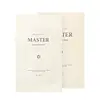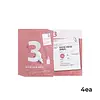What's inside
What's inside
 Key Ingredients
Key Ingredients

 Benefits
Benefits

 Concerns
Concerns

No concerns
 Ingredients Side-by-side
Ingredients Side-by-side

Centella Asiatica Extract
CleansingWater
Skin ConditioningDipropylene Glycol
HumectantGlycerin
HumectantGlycereth-26
HumectantMethyl Gluceth-20
HumectantBifida Ferment Lysate
Skin ConditioningPanthenol
Skin ConditioningSodium Hyaluronate
HumectantCeramide NP
Skin ConditioningMadecassoside
AntioxidantCitrus Nobilis Peel Extract
MaskingCarbomer
Emulsion StabilisingCellulose Gum
Emulsion StabilisingArginine
MaskingPolyglyceryl-10 Laurate
Skin ConditioningDisodium EDTA
Ethylhexylglycerin
Skin ConditioningAllantoin
Skin ConditioningEctoin
Skin ConditioningHydrolyzed Hyaluronic Acid
HumectantCyclodextrin
AbsorbentHydrogenated Lecithin
EmulsifyingCentella Asiatica Extract, Water, Dipropylene Glycol, Glycerin, Glycereth-26, Methyl Gluceth-20, Bifida Ferment Lysate, Panthenol, Sodium Hyaluronate, Ceramide NP, Madecassoside, Citrus Nobilis Peel Extract, Carbomer, Cellulose Gum, Arginine, Polyglyceryl-10 Laurate, Disodium EDTA, Ethylhexylglycerin, Allantoin, Ectoin, Hydrolyzed Hyaluronic Acid, Cyclodextrin, Hydrogenated Lecithin
Water
Skin ConditioningBifida Ferment Lysate 20%
Skin ConditioningGalactomyces Ferment Filtrate 9%
HumectantMethyl Gluceth-20
HumectantGlycereth-26
HumectantGlycerin
HumectantNiacinamide
SmoothingPEG-90
Humectant1,2-Hexanediol
Skin ConditioningMentha Piperita Leaf Extract
Skin ConditioningSolanum Virginianum Extract
Skin ConditioningCamellia Sinensis Leaf Extract
AntimicrobialAnthemis Nobilis Flower Extract
MaskingLemongrass Oil
Pinus Pumilio Branch/Leaf Oil
MaskingBetula Lenta Bark Oil
MaskingLavandula Angustifolia Oil
MaskingRosmarinus Officinalis Leaf Oil
MaskingCedrus Atlantica Bark Oil
MaskingAlteromonas Ferment Extract
Skin ConditioningJasmine Oil/Extract
Silk Extract
Skin ConditioningSqualane
EmollientSodium Hyaluronate
HumectantPanthenol
Skin ConditioningButylene Glycol
HumectantPolyglyceryl-3 Methylglucose Distearate
EmulsifyingPolyglyceryl-3 Distearate
EmulsifyingGlyceryl Stearate Citrate
EmollientGlyceryl Stearate Se
EmulsifyingCaprylyl Glycol
EmollientOctyldodeceth-16
EmulsifyingXanthan Gum
EmulsifyingCarbomer
Emulsion StabilisingTromethamine
BufferingAlcohol Denat.
AntimicrobialEthylhexylglycerin
Skin ConditioningAdenosine
Skin ConditioningDisodium EDTA
Limonene
PerfumingLinalool
PerfumingCitral
PerfumingWater, Bifida Ferment Lysate 20%, Galactomyces Ferment Filtrate 9%, Methyl Gluceth-20, Glycereth-26, Glycerin, Niacinamide, PEG-90, 1,2-Hexanediol, Mentha Piperita Leaf Extract, Solanum Virginianum Extract, Camellia Sinensis Leaf Extract, Anthemis Nobilis Flower Extract, Lemongrass Oil, Pinus Pumilio Branch/Leaf Oil, Betula Lenta Bark Oil, Lavandula Angustifolia Oil, Rosmarinus Officinalis Leaf Oil, Cedrus Atlantica Bark Oil, Alteromonas Ferment Extract, Jasmine Oil/Extract, Silk Extract, Squalane, Sodium Hyaluronate, Panthenol, Butylene Glycol, Polyglyceryl-3 Methylglucose Distearate, Polyglyceryl-3 Distearate, Glyceryl Stearate Citrate, Glyceryl Stearate Se, Caprylyl Glycol, Octyldodeceth-16, Xanthan Gum, Carbomer, Tromethamine, Alcohol Denat., Ethylhexylglycerin, Adenosine, Disodium EDTA, Limonene, Linalool, Citral
 Reviews
Reviews

Ingredients Explained
These ingredients are found in both products.
Ingredients higher up in an ingredient list are typically present in a larger amount.
Bifida Ferment Lysate is derived from the fermentation of Bifida bacteria (often with dairy). It is a probiotic and helps to strengthen our skin's microbiome.
Having a healthy microbiome helps protect our skin against infection. It also helps our skin stay hydrated and healthy.
Studies also show this ingredient to be a promising soothing ingredient for sensitive skin.
Learn more about Bifida Ferment LysateCarbomer is a polymer of acrylic acid. Its main role is to create a gel consistency.
A high amount of carbomer can cause pilling or balling up of products. Don't worry, most products contain 1% or less of carbomer.
Disodium EDTA plays a role in making products more stable by aiding other preservatives.
It is a chelating agent, meaning it neutralizes metal ions that may be found in a product.
Disodium EDTA is a salt of edetic acid and is found to be safe in cosmetic ingredients.
Learn more about Disodium EDTAEthylhexylglycerin (we can't pronounce this either) is commonly used as a preservative and skin softener. It is derived from glyceryl.
You might see Ethylhexylglycerin often paired with other preservatives such as phenoxyethanol. Ethylhexylglycerin has been found to increase the effectiveness of these other preservatives.
Glycereth-26 is a synthetic ingredient and polyethylene glycol ether of Glycerin. Glycerin is already naturally found in your skin and helps keep your skin moisturized.
It is a humectant and helps add texture to products. It can make your product thicker.
As a humectant, it helps draw moisture from the air to your skin. This helps your skin stay hydrated.
Learn more about Glycereth-26Glycerin is already naturally found in your skin. It helps moisturize and protect your skin.
A study from 2016 found glycerin to be more effective as a humectant than AHAs and hyaluronic acid.
As a humectant, it helps the skin stay hydrated by pulling moisture to your skin. The low molecular weight of glycerin allows it to pull moisture into the deeper layers of your skin.
Hydrated skin improves your skin barrier; Your skin barrier helps protect against irritants and bacteria.
Glycerin has also been found to have antimicrobial and antiviral properties. Due to these properties, glycerin is often used in wound and burn treatments.
In cosmetics, glycerin is usually derived from plants such as soybean or palm. However, it can also be sourced from animals, such as tallow or animal fat.
This ingredient is organic, colorless, odorless, and non-toxic.
Glycerin is the name for this ingredient in American English. British English uses Glycerol/Glycerine.
Learn more about GlycerinMethyl Gluceth-20 is a humectant. Humectants help draw moisture from the air to your skin.
It is created by combining polyethylene glycol with glucose.
Panthenol is a common ingredient that helps hydrate and soothe the skin. It is found naturally in our skin and hair.
There are two forms of panthenol: D and L.
D-panthenol is also known as dexpanthenol. Most cosmetics use dexpanthenol or a mixture of D and L-panthenol.
Panthenol is famous due to its ability to go deeper into the skin's layers. Using this ingredient has numerous pros (and no cons):
Like hyaluronic acid, panthenol is a humectant. Humectants are able to bind and hold large amounts of water to keep skin hydrated.
This ingredient works well for wound healing. It works by increasing tissue in the wound and helps close open wounds.
Once oxidized, panthenol converts to pantothenic acid. Panthothenic acid is found in all living cells.
This ingredient is also referred to as pro-vitamin B5.
Learn more about PanthenolSodium Hyaluronate is hyaluronic acid's salt form. It is commonly derived from the sodium salt of hyaluronic acid.
Like hyaluronic acid, it is great at holding water and acts as a humectant. This makes it a great skin hydrating ingredient.
Sodium Hyaluronate is naturally occurring in our bodies and is mostly found in eye fluid and joints.
These are some other common types of Hyaluronic Acid:
Learn more about Sodium HyaluronateWater. It's the most common cosmetic ingredient of all. You'll usually see it at the top of ingredient lists, meaning that it makes up the largest part of the product.
So why is it so popular? Water most often acts as a solvent - this means that it helps dissolve other ingredients into the formulation.
You'll also recognize water as that liquid we all need to stay alive. If you see this, drink a glass of water. Stay hydrated!
Learn more about Water